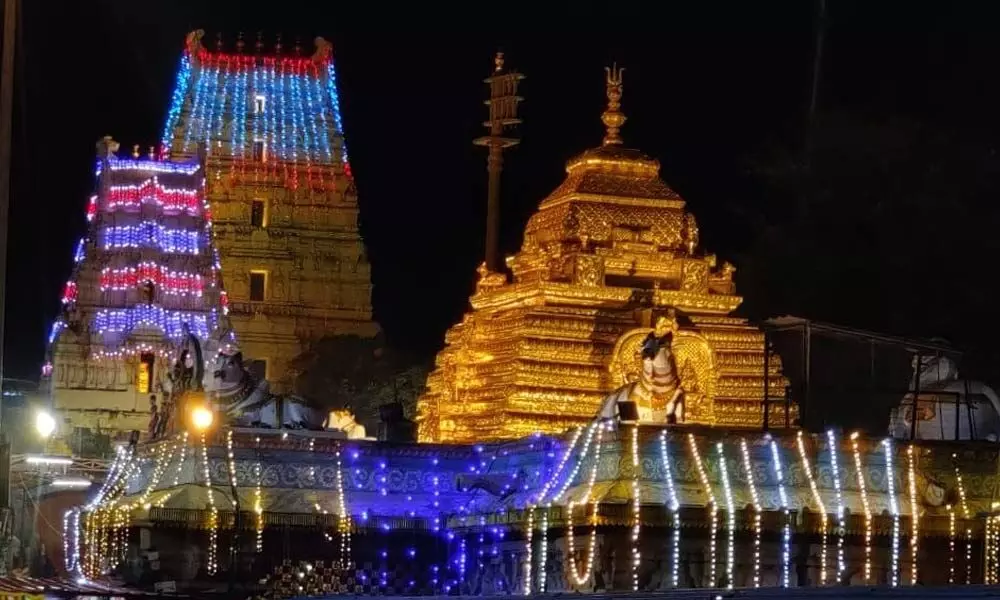Live
- Govt plans to establish offshore Johns Hopkins University Campus in India
- Goa Aces clinch Indian Racing League title
- Study finds how hormone therapy can reshape the skeleton
- High-street fashion players looking at India for manufacturing: Report
- Shreyas Iyer to lead Mumbai as Prithvi Shaw returns for Syed Mushtaq Ali Trophy
- 'Failed to resolve crisis': NPP withdraws support from BJP govt in Manipur
- Chennai: Actress Kasturi Remanded in Custody Until 29th of This Month
- Aaqib Javed likely to become Pakistan's new white-ball head coach
- BJP panel to draft poll charge sheet against AAP govt in Delhi
- Allu Arjun Thanks Fans in Patna, Teases 'Pushpa 2' Release
Just In
Sankranti Brahmotsavams begin on a grand note in Srisailam


Srisailam temple decorated with lights to mark the Sankranti Brahmotsavams on Wednesday
During the week-long celebrations, special prayers will be offered to Lord Mallikarjuna Swamy and Goddess Brahmarambika Devi
Kurnool: Sankranti Brahmotsavams started on a grand note at Srisailam temple on Wednesday. The weeklong Brahmotsavams started on January 12 will conclude on January 16, said the temple Executive Officer (EO) S Lavanna. Speaking to media persons, the EO said that during the week-long celebrations, special prayers would be offered to Lord Mallikarjuna Swamy and Goddess Brahmarambika Devi. Archanalu to Mallikarjuna Swamy and special prayers like rudra homam, chandi homam, navagraha manadaparadhana, kalasarchana, japalu and parayanams would be organised.
On the starting day, as a means of commencing the week long celebrations, the officials, temple archkas and veda pandits have made yaga sala entry. Later the veda pundits have performed chaturveda parayanam and veda swasthi. After veda swasthi, Siva sankalpam has been conducted. The temple archakas and veda pundits have recited Siva sankalpam for the wellbeing of human kind, the country gets timely rains, farmers get reap good harvest, people bestowed with good health besides stopping the occurrence of unfortunate deaths, fire disasters, road accidents and others.
Immediately after siva sankalpam, maha ganapathi puja was performed for the uninterrupted week-long programme. Chandeeshwara puja was also conducted. Chandeeshwara is said to be one among the other Goddess of Lord Shiva. According to a saying Chandeeshwara used to arrange and organise the Brahmotsavams of Lord Mallikarjuna Swamy, S Lavanna said. After Chandeeshwara puja, Kankana puja/kankana dharana was also organised. The officials, archaka swamis and stanacharyulu have tied kankanam to their wrists. Rutwigwaranam was also organised. At rutwigwaranama, the rutwikas would be invited for organising the vaidika programme and deeksha vastrams would be offered to them. Later akhanda deepa stapana, vasthu puja, vastu homam followed by mandaparadhana, panchavarachana, pradana kalastapana programmes were also organised, the EO said.
In the evening, ankurarpana was organised. At the ankurarpana, the soil would be collected from various places in the temple premises and bring to the yagasala following the tradition. The collected soil would be filled in nine bowls along with nine seeds (nava dhanyalu). Later they would be made to sprout by sprinkling water daily.This process of sprouting the nine seeds is called as ankurarapana. After ankurarpana, dwajarohana was organised. Dwajarohana has a great importance in the Brahmotsavams. The aim of dwajarohana is to hoist a flag on the main dwajastambam. Nandeeshwara, the chariot of paramasiva and astamangala pictures (astamangala chitralu) would be printed on a new cloth which is known as "nandi dwaja patam". Later a thread would be woven to tie the nandi dwaja patam to the dwaja stambam.
Prior to hoisting the nandi dwaja patam it would be taken out as a procession up to dwaja stambam and offered prayers in the presence of Chahndeeshwara swamy. As part of dwajarohana, bheri puja was also organised. Prayers would be organised to the drum later the goddess would be invited to Brahmotsavams by playing nadaswaram. Later the dwaja patam would be hoisted. The dwaja patam is the indication of invitation to the gods and goddess to the Brahmotsavams, stated the EO.

© 2024 Hyderabad Media House Limited/The Hans India. All rights reserved. Powered by hocalwire.com






